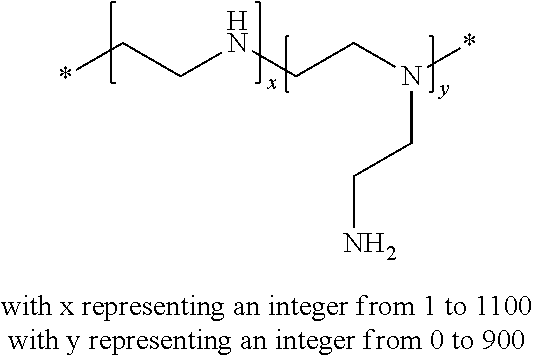Polymeric dispersants and non-aqueous dispersions
a technology of polymeric dispersants and non-aqueous dispersions, applied in the direction of polyether coatings, inks, coatings, etc., can solve the problems of reducing the dispersing energy required, dispersed pigment particles may have a tendency to re-agglomerate, and the preparation of good thermally stable dispersions with submicron particles is more difficult for non-aqueous inkjet inks to achieve the effect of high image quality
- Summary
- Abstract
- Description
- Claims
- Application Information
AI Technical Summary
Benefits of technology
Problems solved by technology
Method used
Image
Examples
example 1
[0159]This example illustrates the synthesis method of polymeric dispersants in accordance with a preferred embodiment of the present invention.
[0160]Synthesis of oxalylamide-methyl 4-pyridine
2.2 g of oxalic acid dimethyl ester (0.018 mol) was dissolved in 12.6 mL of methyl acetate in a three-neck flask equipped with a magnetic stirrer, a thermometer and a nitrogen inlet. The mixture was cooled to −20° C. with a dry ice / ethanol bath. Then, 2 g of 4-aminomethylpyridine (0.018 mol) dissolved in 25.1 mL of methyl acetate were added drop wise at −20° C. over 2 hours. An excess of oxalic acid dimethyl ester (1.1 g, 0.009 mol) was added with a funnel to the reaction mixture under constant stirring. The completion of the reaction was determined via thin layer chromatography (TLC) by using MERCK™ TLC Silica Gel 60 F254 plates and CH2Cl2 / MeOH 90 / 10 were used as stationary and mobile phase, respectively. The precipitated solid present in the crude reaction mixture was removed by filtration ov...
example 2
[0177]This example illustrates the advantage in dispersion stability of the polymeric dispersant in accordance with a preferred embodiment of the present invention for preparing a CMY-inkjet ink set.
Preparation of Inkjet Ink Sets
[0178]All the comparative inkjet ink sets COMP-1 to COMP-3 and inventive inkjet ink sets INV-1 to INV-9 were prepared in the same manner to obtain a composition as described in Table 9, using the pigments of Table 10 and the polymeric dispersants according to Table 11.
TABLE 9Yellow inkMagenta inkCyan inkComponentwt %wt %wt %Pigment5.005.005.00Dispersion synergist S2——1.25Polymeric dispersant5.005.005.00DEGDEE90.0090.0088.75
TABLE 10Ink of ink setPigmentYellow inkNovoperm ™ Yellow H2GMagenta inkHostaperm ™ Red E5B02Cyan inkSunfast ™ blue 15:3
TABLE 11InkjetPolymericink setdispersantCOMP-1S35000COMP-2S32000COMP-3EFKA ™ 7476 DRYINV-1POL-1INV-2POL-2INV-3POL-3INV-4POL-4INV-5POL-5INV-6POL-6INV-7POL-7INV-8POL-8INV-9POL-9
[0179]A pigment dispersion was made by mixing t...
example 3
[0182]This example illustrates the advantages in adhesion to substantially non-absorbing ink receivers of a UV-curable inkjet inks containing a polymeric dispersant in accordance with a preferred embodiment of the present invention.
Preparation of Inkjet Inks
[0183]All the comparative UV curable inkjet inks COMP-4 to COMP-5 and the inventive UV curable inkjet inks INV-10 to INV-20 were prepared in the same manner to obtain a composition as described in Table 13 using a polymeric dispersant according to Table 14.
TABLE 13Componentwt % in the inkPolymeric dispersant3.00SAVINYL ™ blue GLS2.00GENORAD ™ 161.05BYK ™ UV 35100.10ITX5.00TPO4.95GENOCURE ™ EPD5.00DPGDA78.90
TABLE 14InkjetPolymericinkdispersantCOMP-4S35000COMP-5D162 solCOMP-6D162 dryCOMP-7S32000INV-10POL-1INV-11POL-2INV-12POL-3INV-13POL-4INV-14POL-5INV-15POL-6INV-16POL-7INV-17POL-8INV-18POL-9INV-19POL-10INV-20POL-11
[0184]A UV curable inkjet ink was made by mixing the polymeric dispersant, the dye, the photoinitiating system, the st...
PUM
| Property | Measurement | Unit |
|---|---|---|
| Fraction | aaaaa | aaaaa |
| Fraction | aaaaa | aaaaa |
| Fraction | aaaaa | aaaaa |
Abstract
Description
Claims
Application Information
 Login to View More
Login to View More - Generate Ideas
- Intellectual Property
- Life Sciences
- Materials
- Tech Scout
- Unparalleled Data Quality
- Higher Quality Content
- 60% Fewer Hallucinations
Browse by: Latest US Patents, China's latest patents, Technical Efficacy Thesaurus, Application Domain, Technology Topic, Popular Technical Reports.
© 2025 PatSnap. All rights reserved.Legal|Privacy policy|Modern Slavery Act Transparency Statement|Sitemap|About US| Contact US: help@patsnap.com



